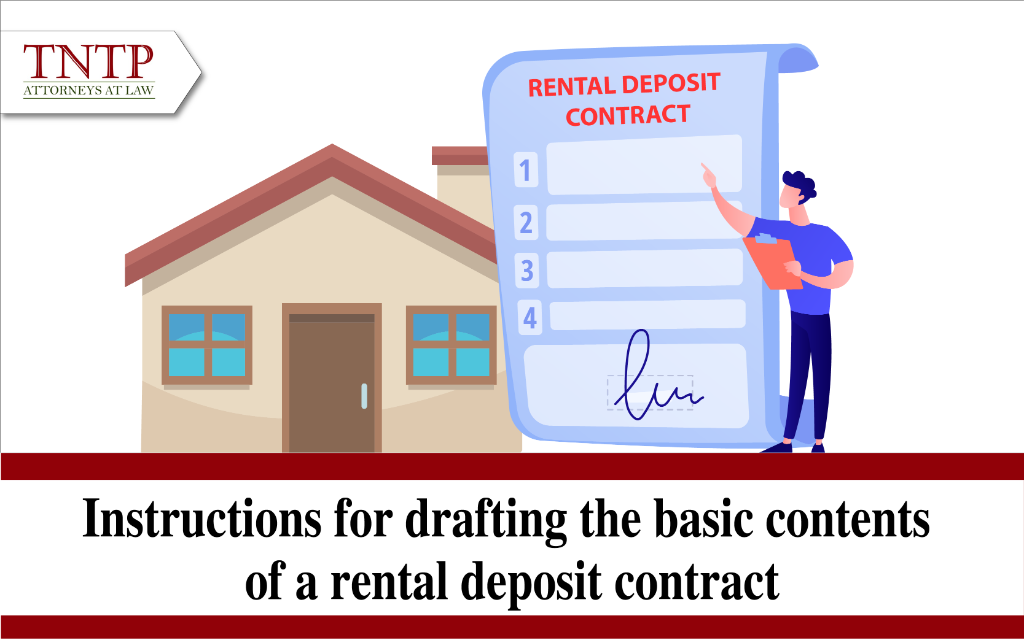Instructions for drafting the basic contents of a rental deposit contract

A deposit contract is a form of agreement aimed at binding parties in various civil transactions. In practice, parties may use deposits to secure the signing of a land use rights transfer contract, a sale and purchase agreement, a lease agreement, and more. In this article, TNTP will present the essential points that parties should consider when drafting a rental deposit contract.
1. Information of the parties
A rental deposit contract should clearly and completely express the information of the involved parties, including the depositor and the depositary. If individuals are involved, detailed information such as full name, ID card information, contact address, phone number, email, etc., should be provided. If legal entities are involved, details such as the name, main office address, tax identification number, and information about the legal representative or authorized signatory should be supplied.
2. Purpose of the deposit
In this section, parties need to agree on the purpose of the deposit. For example, the deposit could be to ensure the signing of a lease agreement. Additionally, basic information about the property for rent should be stipulated, including the type of property, location, address, dimensions (total floor area, total land use area), structure, number of floors, and intended use.
3. Deposited property
Parties need to specify the type of property being deposited, documentation related to the property (if any), and the agreed-upon total value of the deposited property. It’s crucial to note that the deposited property can only be money or other valuable items such as precious metals, gemstones, or other valuable objects. Typically, the deposited property is money, and in this case, the parties need to specify the exact amount.
4. Method and deadline for deposit payment
Parties should stipulate the payment method and the deadline for deposit payment. Payment methods can include cash or bank transfers. In the case of a bank transfer, specific account information of the depositary should be provided. Regarding the payment deadline, parties need to define a specific timeframe within which the depositor must make the payment to the depositary, for example, within 05 days from the date of signing the deposit contract.
5. Deposit agreement
Parties need to include details such as the rental period, rental price, and the execution of the lease agreement.
For rental price details, the parties should specify whether the rental price includes value-added tax and other taxes or fees such as electricity, water, telephone, fax, internet, sanitation service fees, etc., and determine the responsibility for paying these taxes or fees.
Concerning the execution of the lease agreement, parties need to stipulate that within a specific timeframe, the parties must sign the lease agreement with conditions and terms inherited from the agreement of this deposit contract.
Parties should agree on the legal consequences if one of the parties fails to sign the lease agreement. For instance, if the depositor fails to sign the agreement within the specified timeframe, it is considered a refusal to enter into the lease agreement, and the depositary has the right to lease to another party. In such a case, the deposited amount is not refunded. Conversely, if the depositary fails to sign the lease agreement, they must refund the deposited amount and an additional amount equal to the deposited amount to the depositor.
Parties need to agree on how to handle the deposited amount after signing the lease agreement. Options include deducting the deposited amount from the payment under the lease agreement or returning it when the parties sign the lease agreement.
6. Force majeure event
For this type of contract, parties should agree on a force majeure clause, defining a force majeure event, the responsibilities of the party encountering a force majeure event, and the exoneration of liability for the party facing a force majeure event.
7. Effectiveness and termination of the contract
Parties need to agree on the contract’s effective period, the cases in which the contract will terminate, and the legal consequences when the contract is terminated. For example, parties may agree on circumstances leading to early termination, such as i) mutual agreement in writing, ii) if any contract violation is not rectified within a specific timeframe from the date of receiving a rectification request from the non-violating party. In this case, the non-violating party has the right to unilaterally terminate the contract by sending a written notice to the violating party; iii) if a force majeure event lasts beyond a specified number of days from the occurrence date, this contract can be terminated based on written notice from one party to the other.
8. Dispute resolution
In this clause, parties need to agree on dispute resolution methods such as negotiation, mediation, dispute resolution in court, or arbitration (with attention to conditions for arbitration). Typically, parties may choose negotiation for dispute resolution when a dispute arises. In case negotiation is unsuccessful, the parties may initiate legal proceedings by filing a lawsuit in a court with jurisdiction over dispute resolution.
The above are the contents of the article “Instructions for drafting the basic contents of a rental deposit contract”. It is hoped that these insights are helpful for those interested in this matter.
Best regards,



